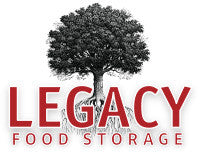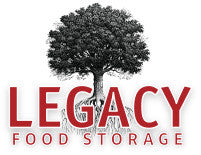Saving Seeds: A Perfect Complement to Food Storage
In a long-term survival situation, knowing how to garden and grow your own produce is great, but if you haven’t planned ahead, where are you going to get your seeds? If it’s enough of an emergency that the grocery store is not an option, then that garden center down the road is probably not going to have open doors either. Saving and storing seeds is a great complement to stocking up on emergency food storage and emergency supplies, and the good news is, almost all seeds are storable.
Saving seeds is not just a wise emergency preparedness practice; it’s also a great idea when you simply find a fruit or vegetable you like and want to enjoy it for years to come. A few years ago, our garden offered us a little surprise gift in the form of a strange melon that sprouted in the middle of our compost pile. (This sort of thing happens most years and is, in my opinion, one of the best parts of composting.) The melon grew into a delicious cantaloupe/honeydew-type fruit and was one of the sweetest, juiciest garden offerings I have yet tasted. At the end of the season, we naturally wanted to save the seeds and plant them again the next year. So we scraped the seeds out of our last melon at the end of the summer, threw them in a bag, and tossed them in the cupboard above the stove.
Let’s stop the story right there. Do you see anything wrong? If you are a seasoned seed saver, you will know that we violated almost every rule of seed saving there is to violate.
To help you avoid my mistake and to give you even more tricks to keep up your emergency preparedness sleeve, here is your beginner’s guide to seed saving.
One of the simplest ideas to keep in mind when you are getting ready to store seeds is to do the exact opposite of what you would do if you were trying to get the seed to grow. If you were trying to get it to grow, of course, you would give it plenty of water and moisture and expose it to sunlight and oxygen and adequate heat. If you want to inhibit its growth, then, you want to be sure to do the exact opposite: eliminate moisture, keep it cold, and store it out of the sun in an airtight container. Remember: dry, airtight, cold, dark.
1. Remove the seeds from the plant and clean them with water. Many experts recommend allowing the fruit or vegetable to become overripe before removing the seeds. For more specific tips on each individual fruit and vegetable, check out the Seed Savers Exchange’s detailed list of instructions for collecting seeds from each type of fruit/vegetable: http://www.seedsavers.org/Education/Seed-Saving-Instructions
2. Eliminate moisture. After cleaning the seeds well with water, allow them to dry fully. Drying can take a week or several weeks. You’ll know the seeds are done drying when they break instead of bending. It’s important to keep the seeds out of sunlight while they are drying, as sunlight can ruin them. If you live in a humid area, you might also consider using silica gel to dry the seeds to the lowest moisture content possible before storing.
3. Store the seeds in an airtight container. Glass jars with lids are a good option. Ziploc bags can work too. Anything that is airtight and not going to let in moisture or insects is going to work well and keep your seeds viable.
4. Keep seeds in a cold, dark place. Seeds save best when they are stored at cold temperatures, ideally anywhere from just above freezing to about 45 degrees. Especially important is that you find a place that will have a consistent cold temperature. Cellars can be a good option because they stay consistently cold and dark. Many people also recommend the freezer as well, but be sure not to put your seeds in the refrigerator because moisture can accumulate there as people open and close the refrigerator door repeatedly.
Now, you are set. How long will the seeds last? Under perfect conditions, maybe you’ll be this lucky: http://www.bloomberg.com/news/2012-02-20/32-000-year-old-plant-reborn-from-ancient-fruit-found-in-siberian-ice.html. Seriously, though, seed-saving is not an exact science. The storage time for seeds can vary a lot depending on storage conditions and the type of seed. In general, larger seeds save longer and smaller seeds usually have a shorter shelf life. Typically, the range is from 1-5 years, meaning every few years you may want to cycle your seeds out and save some new ones. If you have used silica gel to remove moisture and have stored the seeds in the freezer, some say your seeds will easily last ten or more years.
Experiment a little and find your favorite varieties. Select fruits and vegetables and even herbs that your family loves, and get in the habit of saving seeds at the end of every growing season. Then add them to your emergency food stash. Saving seeds is not hard to do, and it’s easy to imagine the benefits of having fresh produce on hand along with your emergency food storage in a survival situation.
Other Helpful Resources:
http://www.nativeseeds.org/index.php/resources/seedsaving
http://howtosaveseeds.com/store.php
http://www.motherearthliving.com/vegetable-gardening/how-to-save-seeds-drying-seeds-for-storage.aspx
The post Saving Seeds: A Perfect Complement to Food Storage appeared first on Buy Emergency Food.
Tags
- All
- 25 year food
- 25 year shelf life food
- 72 hour kit
- Best food storage types
- Best long-term food storage
- Blizzard preparedness
- Budgeting
- canning
- Certified GMO-free Emergency foods
- Certified GMO-free foods
- Coffee
- Comparison of emergency food methods
- Composting tips
- Dangers of genetically modified foods
- dehydrated food
- Edible Wild Plants
- emergcy preparedness
- Emergency Cooking
- Emergency Food
- Emergency food Christmas gifts
- emergency food storage
- Emergency Food Supply
- Emergency food supply recommendations
- Emergency Planning
- Emergency Preparedness
- Emergency preparedness advice
- emergency preparednesss
- Emergency Supplies
- Emergency supplies checklist
- Emergency Survival
- emergency survival gear
- Emergency survival kit checklist
- Emergency Survival skills
- exercise
- Family emergency preparedness
- Family emergency preparedness plan
- Family Preparedness
- Food Storage
- Food storage 25 year shelf life
- Food storage amounts
- Food storage Christmas
- Food storage containers long term
- Food Storage Secrets
- Food storage serving size
- Food storage types compared
- freeze dried food
- Freeze dried food storage
- freeze dried meats
- Freeze-dried emergency food storage
- Fruit Trees
- Gardening
- Getting Started
- Gluten-free food Storage
- Gourmet emergency food
- Healthy food storage
- How much emergency food to store
- Improved emergency preparedness
- Jared Markin
- Jared Matkin
- Legacy Premium
- Lessons learned from Hurricane Sandy
- Lessons learned from natural disasters
- long-term food storage
- Long-term Food Storage Guidelines
- Long-term Food Storage tips
- Long-term water storage
- Mental Emergency Preparedness
- Mental toughness
- Money-saving tips
- Natural disaster planning
- Natural Disasters
- Perfect Christmas gifts
- Pet Emergency preparedness checklist
- Pet Emergency preparedness kit
- Pet Emergency Survival tips
- Pets and Emergency Preparedness
- Plant Foraging
- portable solar panels
- portable solar power
- portable water filters
- protein drinks
- Risk of genetic modification
- Seed saving and storage
- Seed saving guide
- Self-reliance
- Self-reliant practices
- Shelf Life
- Solar Cooking
- Solar Ovens
- Special Dietary needs
- Stranded in a car in a blizzard
- Survival food
- Survival Gear
- survival kit
- Survival kits
- Survival Ovens
- Survival Skills
- survivalist gear
- suvival kit
- Tree Pruning tips
- Tree Trimming basics
- unique ideas
- water bottle with filter
- water filter
- water filter straw
- water filters
- Water Filtration
- water pitcher with filter
- water pitchers with filters
- Water purification
- Wild Food Foraging
- Winter composting
- Winter driving
- Winter preparedness tips
- Winter storm preparedness tips
- Winter Survival








